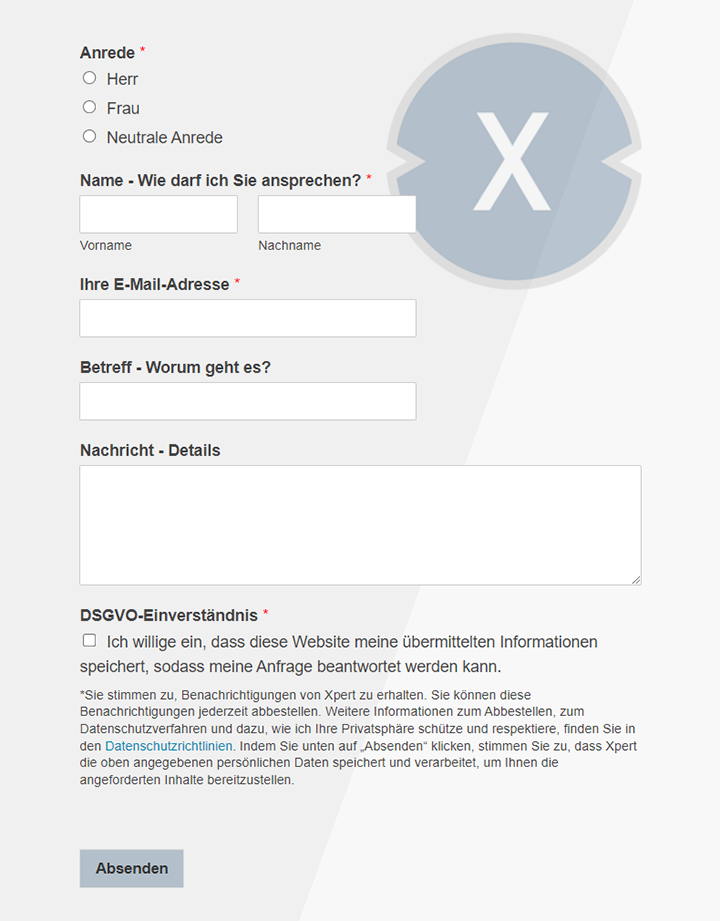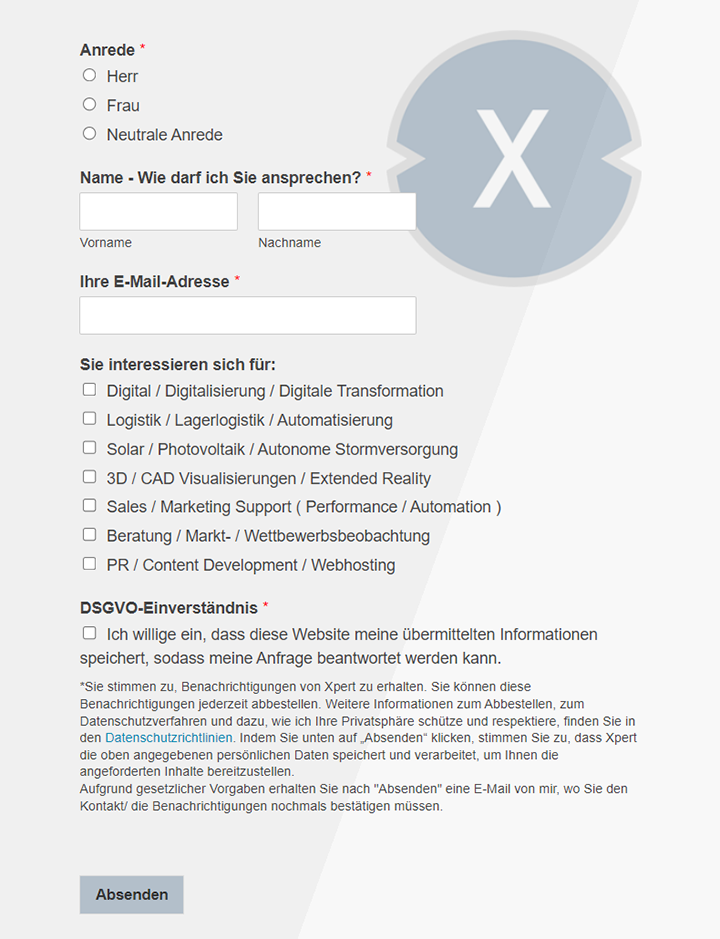6 months, 18 investigators, 0 success: Then the AI came along and solved the case in 20 minutes – AI-supported investigation software MoNA
Xpert pre-release
Language selection 📢
Published on: September 5, 2025 / Updated on: September 5, 2025 – Author: Konrad Wolfenstein

6 months, 18 investigators, 0 successes: Then the AI came along and solved the case in 20 minutes – AI-supported investigation software MoNA – Image: Xpert.Digital
90% less reading effort: This ingenious software finds the needle in the data haystack for investigators
AI-supported investigation software revolutionizes police work in Germany
###"MoNA": Germany's new miracle weapon against crime cracks every case ### The silent revolution: How an AI from Braunschweig is changing German police work forever ### Criminals use AI – but the German police are now striking back with their own super software ###
Born out of necessity: How an unsolvable case led to the birth of Germany's cleverest investigative AI
Imagine: 18 investigators struggle for six months to sift through a seemingly insurmountable flood of cell phone data. Then a piece of software comes along and completes the same task in just 20 minutes. What sounds like science fiction is already reality in Germany and marks a turning point in crime fighting. We're talking about "MoNA," a revolutionary AI-supported investigative software developed by the Cybercrime Department in Braunschweig in collaboration with Mittweida University of Applied Sciences.
This innovation is more than just a technical breakthrough; it is the answer to the greatest challenge facing modern police work: the gigantic amounts of data generated during crime investigations. Given the increasing professionalism of cybercriminals, who themselves have long since embraced AI technologies, MoNA offers officers a crucial tool to master the situation. The software analyzes, translates, and links chat histories, uncovers criminal networks, and reduces manual analysis effort by up to 90 percent. But this tremendous advance also raises important questions: How is data protection guaranteed, what legal limits exist, and what does the digital future of crime fighting in Germany look like? MoNA's success story not only provides fascinating insights into the present but also a groundbreaking outlook on police work of tomorrow.
The innovation from Braunschweig is changing the fight against crime
The German police are experiencing a technological revolution. With the development of advanced AI-supported analysis software by the Cybercrime Department in Braunschweig in collaboration with Mittweida University of Applied Sciences, a new era of investigative work is emerging. These innovations demonstrate how artificial intelligence can dramatically increase the efficiency of police work while simultaneously creating new challenges in handling digital evidence.
The MoNA software, whose full name is Mobile Network Analyzer, represents a breakthrough in the forensic analysis of mobile communication data. This technological achievement is not just a local success, but has already attracted the interest of European law enforcement agencies and is considered a unique solution to the challenges of modern cybercrime.
The birth of a revolutionary technology
The origins of MoNA are closely linked to a spectacular case of investment fraud that pushed Braunschweig investigators to their limits two and a half years ago. Analyzing 46 confiscated mobile phones from an internationally operating fraud gang proved to be a virtually impossible task given the available human resources. Eighteen investigators worked for six months to sift through the massive amounts of data without reaching a satisfactory conclusion.
This experience led to an intensive search for technical solutions that would enable a faster understanding of communication processes and crime patterns. The Cybercrime Unit of the Braunschweig Central Criminal Investigation Department recognized the need for a fundamentally different approach and initiated the development of specialized software in cooperation with Mittweida University of Applied Sciences in Saxony.
The result of this collaboration was impressive: What eighteen investigators hadn't been able to accomplish in six months, MoNA accomplished in just twenty minutes. This dramatic increase in efficiency marked the beginning of a new era in digital forensics and demonstrated the enormous potential of artificial intelligence in law enforcement.
Technical functionality and capabilities
MoNA is based on an innovative concept of semantic data analysis that goes far beyond conventional search functions. At the heart of the software is a semantic dictionary in the form of a complex term graph. This links individual key terms and patterns into semantic chains, representing each term not as a simple textual occurrence, but as a vector of possible manifestations, including synonyms and foreign-language variants.
The software uses statistics, algorithms, and artificial intelligence to filter and analyze mobile data from end devices. It can search for suspicious chat histories, frequent communication partners, criminal networks, or repeatedly used terms. According to Mario Krause, head of the Cybercrime Unit, this functionality saves investigators about 90 percent of the reading work otherwise required.
A particularly valuable aspect of MoNA is its translation and transcription capabilities. Image, audio, and video files are automatically transcribed and analyzed. Language barriers are no problem for the software, as it can translate messages into the desired language. This functionality is invaluable for investigators given the increasingly international dimension of cybercrime.
The software enables interactive analysis, incorporating the investigators' experience and case knowledge. This approach considers the uniqueness of each individual case and ensures that human expertise is not replaced by technology, but rather enhanced.
Increased efficiency in investigative work
The practical impact of MoNA on investigative work is revolutionary. Mario Krause reports an increase in efficiency by a factor of ten to twelve. This dramatic improvement enables officers to understand communication content and identify relevant evidence significantly faster.
With every new investigation, investigators must first identify which information is relevant to potential crimes. This initial assessment, which could previously take weeks or months, is reduced to a few hours or even minutes with MoNA. The software can pre-sort large amounts of data and prioritize the information likely to be relevant, allowing investigators to focus their time and energy on the truly important aspects of a case.
The time savings are particularly significant in cases of organized crime, where many devices are often involved, yet not all of them contain the complete communication history. Due to individual deletions of messages or different times of joining groups, the communication is highly fragmented. MoNA can link these fragmented communication histories and enable a near-complete reconstruction of the communication, while simultaneously reducing the reading effort by merging identical messages.
Distribution and acceptance
Since last year, police throughout Lower Saxony have been able to use the MoNA software. This statewide implementation demonstrates the authorities' confidence in the technology and its practical applicability. The successes have led to interest from other European law enforcement agencies in the software.
The Lower Saxony Ministry of the Interior considers the use of artificial intelligence in police work to be of great importance, especially in the review of large amounts of data in the context of investigations. Ministry spokespersons predict that further AI functionalities will become an integral part of police investigative work in the coming years.
For Braunschweig investigators, MoNA has already become an indispensable tool in the fight against cybercriminals. The software has proven so valuable that it is now used in all major cybercrime investigations.
The scientific basis
The development of MoNA is closely linked to the scientific work at Mittweida University of Applied Sciences. As part of his dissertation, Dr. Michael Spranger developed a comprehensive platform for analyzing mobile communications. The concept is based on the insight that, given the unique nature of each individual case, only an interactive solution that incorporates the experience and case knowledge of an investigator can be successful.
The Communication Forensics research group at Mittweida University of Applied Sciences focuses on supporting law enforcement agencies in two fundamental tasks: analyzing mobile communications and social networks. For these two areas, researchers develop and adapt text mining methods to facilitate the analysis of vast volumes of messages and posts and to identify case-relevant content and relationships between suspects.
The Baden-Württemberg State Office of Criminal Investigation is funding the further development of the software, thus enabling the long-term implementation of additional intelligent services that will make MoNA an internationally competitive analysis solution for mobile devices. In addition, NUIX, one of the global market leaders in forensic software solutions and services, plans to integrate MoNA into its system landscape.
A new dimension of digital transformation with 'Managed AI' (Artificial Intelligence) - Platform & B2B Solution | Xpert Consulting

A new dimension of digital transformation with 'Managed AI' (Artificial Intelligence) – Platform & B2B Solution | Xpert Consulting - Image: Xpert.Digital
Here you will learn how your company can implement customized AI solutions quickly, securely, and without high entry barriers.
A Managed AI Platform is your all-round, worry-free package for artificial intelligence. Instead of dealing with complex technology, expensive infrastructure, and lengthy development processes, you receive a turnkey solution tailored to your needs from a specialized partner – often within a few days.
The key benefits at a glance:
⚡ Fast implementation: From idea to operational application in days, not months. We deliver practical solutions that create immediate value.
🔒 Maximum data security: Your sensitive data remains with you. We guarantee secure and compliant processing without sharing data with third parties.
💸 No financial risk: You only pay for results. High upfront investments in hardware, software, or personnel are completely eliminated.
🎯 Focus on your core business: Concentrate on what you do best. We handle the entire technical implementation, operation, and maintenance of your AI solution.
📈 Future-proof & Scalable: Your AI grows with you. We ensure ongoing optimization and scalability, and flexibly adapt the models to new requirements.
More about it here:
How AI is revolutionizing the German police — opportunities and limitations
Further AI applications in German police work
The development of MoNA is part of a broader trend toward the digitalization of police work in Germany. In addition to MoNA, the Lower Saxony State Criminal Police Office has developed two other AI-based tools: Tracebook Chats and the Kipo Analyzer.
Tracebook Chats focuses on processing communication data, as well as providing transcription and translation services. The software is designed to provide investigators with the best possible support in analyzing previously encrypted messenger data while minimizing the time required for analysis. Following a successful test phase, Tracebook Chats is now available to targeted users in all Lower Saxony police departments.
The Kipo Analyzer and Tracebook Kipo were developed specifically for caseworkers dealing with child pornography. Using AI, the Kipo Analyzer can quickly classify large amounts of data for pornographic content and prioritize this data using a preliminary analysis. These results can be used in Tracebook Kipo, supporting police investigators and analysts in their analysis and significantly reducing the time required.
Data protection and legal framework conditions
The introduction of AI-supported analysis systems in police work raises important questions regarding data protection and the legal framework. In its Hessendata decision, the Federal Constitutional Court set clear standards for the use of AI in police work. The court emphasizes that self-learning systems may only be used in police work under special procedural precautions that ensure a sufficient level of protection despite the limited traceability.
The analysis of cell phone data represents a massive invasion of privacy and is therefore only permissible under certain conditions. There must be strong suspicion of a crime, the intrusion must be proportionate, and a court order is generally required. These legal limits ensure that technological possibilities do not lead to an unjustified expansion of surveillance powers.
The proportionality of a mobile phone analysis exists if the measure is proportionate to the seriousness of the crime and the importance of the evidence. For serious crimes such as organized drug trafficking or terrorism, the use of AI-supported analysis systems may be justified, whereas for minor offenses, proportionality would not be given.
The evidence cloud as a vision of the future
Another forward-looking project is the development of an evidence cloud by the Lower Saxony Ministry of the Interior, the Ministry of Justice, and the State Criminal Police Office. The goal is to develop a shared platform to make the storage, processing, and analysis of digital evidence by the police and the judiciary more efficient and secure.
The evidence cloud is intended to ensure cross-system, target-group-specific, and legally compliant network access. Digital evidence should be accessible, analyzable, and assessable to all colleagues, regardless of their workplace location. This would revolutionize collaboration between different authorities and organizations.
The project is planned to run for at least two years and will gather initial key findings by the end of the year. The evidence cloud will achieve its full potential when future-proof, high-performance, AI-supported analysis tools can be integrated and made operational on the platform. These would finally make it possible to establish crucial links to the crime quickly, comprehensively, and seamlessly.
Challenges and threats
The development of cybercrime presents growing challenges for law enforcement agencies. In 2024, a total of 131,391 cybercrime offenses were registered in Germany. A further 201,877 offenses were committed abroad or from an unknown location. These figures demonstrate the extent of the threat and underscore the need for efficient technological solutions.
The damage caused by cyberattacks is immense. According to a survey by the Bitkom association, they caused €178.6 billion in damage in 2024. That's €30 billion more than in the previous year. The greatest threat continued to come from ransomware attacks, in which attackers encrypt computers and only release them in return for a ransom.
Criminals are increasingly using AI technologies for their own purposes. They can use AI to optimize and improve malware without having to adhere to legal or ethical restrictions. This asymmetric situation, in which criminals can use the technology unhindered while law enforcement agencies are bound by legal requirements, presents a particular challenge.
The future of police AI use
The development of AI-supported systems in police work is still in its early stages. Various federal states are working on implementing further AI applications. North Rhine-Westphalia is currently building its own infrastructure for providing AI applications, and the first AI applications for analyzing mass data are expected to be operational this year.
Lower Saxony is planning to be one of the first federal states to use AI for threat prevention. With the help of AI, the Lower Saxony police will soon be able to automatically recognize faces, voices, and movement patterns. These technologies are intended to help them more quickly identify dangerous situations or suspicious behavior patterns.
A prominent example of the successful use of AI in police work is the arrest of suspected former RAF terrorist Daniela Klette. Journalists tracked down Klette, who is now on trial, using a facial recognition program. The computer calculated what Klette would look like in old age based on old photos on the internet, and thus they were able to track her down.
International perspectives and cooperation
The successes of German AI developments in police work have also attracted international attention. The MoNA communications analysis software is unique in Europe and is attracting interest from other European investigative authorities. This international recognition underscores the quality and innovative strength of German developments.
Collaboration between universities and law enforcement agencies is proving particularly fruitful. The collaboration between Mittweida University of Applied Sciences and the Braunschweig Cybercrime Unit demonstrates how academic research and practical police work can mutually enrich each other.
Mittweida University of Applied Sciences has established itself as a center of excellent applied research and offers various degree programs in the fields of IT forensics and cybercrime. These educational offerings respond to the growing demand for specialists in public authorities and contribute to the long-term preservation of specialist knowledge.
Fair algorithms: How police AI becomes comprehensible and legally secure
The use of AI in police work raises important societal and ethical questions. While the technology undoubtedly has the potential to improve crime detection and increase public safety, citizens' fundamental rights must also be protected.
The transparency and traceability of AI decisions is a key concern. Investigators must be able to understand how the AI reached its conclusions in order to evaluate the results and defend them in court. Forensic evaluation must always remain with humans, even if AI systems assist with pre-sorting and analysis.
The risk of discriminatory algorithms is another important issue. AI systems can unconsciously reinforce prejudices or disadvantage certain population groups. Therefore, special procedural safeguards are necessary to ensure an adequate level of protection.
The digital future of police work
The development of MoNA and other AI-based systems marks the beginning of a new era in police work. The dramatic increase in efficiency enabled by these technologies enables law enforcement agencies to keep pace with rapidly growing cybercrime.
The future will bring further innovations. Virtual police avatars could guide citizens through reporting procedures, automatic translations could overcome language barriers, and intelligent analytics could help prevent crimes before they happen.
At the same time, the legal framework must be continuously adapted to both utilize the possibilities of technology and protect citizens' fundamental rights. Balancing security and freedom will remain a key challenge.
MoNA's success story demonstrates that Germany has the potential to take a leading role in the development and application of AI in law enforcement. Combining scientific excellence, practical experience, and rule-of-law principles can create innovative solutions that are both effective and legally compliant.
Police work of the future will be increasingly digital and AI-supported. MoNA is just the beginning of a development that has the potential to fundamentally change the way crime is fought. The challenge is to use these technologies responsibly while upholding the democratic values and constitutional principles that shape our society.
EU/DE Data Security | Integration of an independent and cross-data source AI platform for all business needs
Ki-Gamechanger: The most flexible AI platform-tailor-made solutions that reduce costs, improve their decisions and increase efficiency
Independent AI platform: Integrates all relevant company data sources
- Fast AI integration: tailor-made AI solutions for companies in hours or days instead of months
- Flexible infrastructure: cloud-based or hosting in your own data center (Germany, Europe, free choice of location)
- Highest data security: Use in law firms is the safe evidence
- Use across a wide variety of company data sources
- Choice of your own or various AI models (DE, EU, USA, CN)
More about it here:
We are there for you - advice - planning - implementation - project management
☑️ SME support in strategy, consulting, planning and implementation
☑️ Creation or realignment of the AI strategy
☑️ Pioneer Business Development
I would be happy to serve as your personal advisor.
You can contact me by filling out the contact form below or simply call me on +49 89 89 674 804 (Munich) .
I'm looking forward to our joint project.
Xpert.Digital - Konrad Wolfenstein
Xpert.Digital is a hub for industry with a focus on digitalization, mechanical engineering, logistics/intralogistics and photovoltaics.
With our 360° business development solution, we support well-known companies from new business to after sales.
Market intelligence, smarketing, marketing automation, content development, PR, mail campaigns, personalized social media and lead nurturing are part of our digital tools.
You can find out more at: www.xpert.digital - www.xpert.solar - www.xpert.plus























